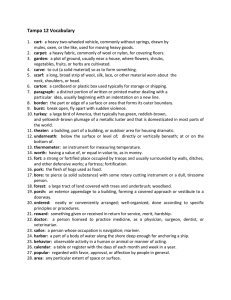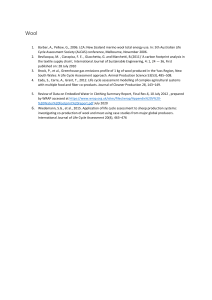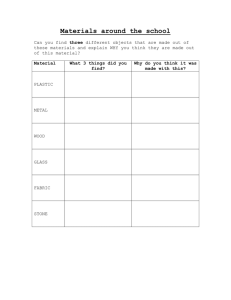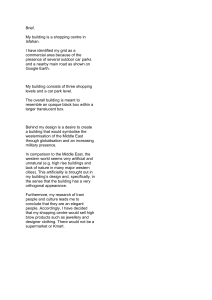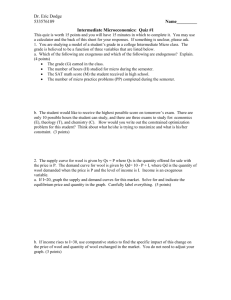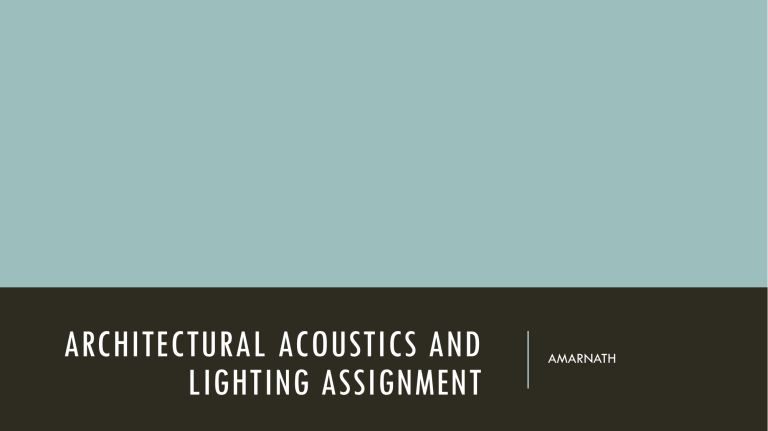
ARCHITECTURAL ACOUSTICS AND LIGHTING ASSIGNMENT AMARNATH CHETTINAD HEALTH CITY AUDITORIUM INTRODUCTION • NAME :CHETTINAD HEALTH CITY AUDITORIUM • ARCHITECT :MORPHOGENESIS • YEAR OF COMPLETION : 2010 • AREA: 5500 SQM • LOCATION : CHENNAI ,TAMIL NADU • CAPACITY: 650 PEOPLE PLANNING & DESIGN IDEA • The project brief entailed the fitting-out and interiors of an auditorium facility for Chettinad Health city, to be used as part of the medical institute. • The auditorium facility been designed to cater to a diverse activities such as stage performances, lectures or seminars, projection of recorded medical information web-casts & broadcasts etc. • The design intent was to shift away from the typical morphology in order to create a more visually dynamic space. OVERALL PLANNING • THE THEATRE IS OF A FAN SHAPED TYPOLOGY. • THE AUDITORIUM IS SURROUNDED BY 2 FOYERS EACH OF 130 SQM. • TWO STAIRCASES OCCUPYING AREA OF 30 M2 EACH IS LOCATED ON BOTH SIDES • TOILETS ON BOTH SIDES ARE LOCATED ADJOINING THE FOYER EACH WITH 6 CUBICLES( MEN AND WOMEN) AND AN AREA OF 70 sqm. • At the back stage there is a 6m wide corridor . • Beside this corridor various spaces such as 1.conference rooms 2. lift lobby FOYER DETAILS • DISTANCE BETWEEN SEATS AND STAGE: 4.2 M • HEIGHT OF THE CEILING : 3.5 M IN THE LAST ROW 7.2 M FROM THE FIRST ROW 6.5 M FROM THE STAGE • DISTANCE BETWEEN EACH ROW ( SEATING) : 0.50 M SECTION DETAILS • SLOPE ANGLE : 10 dEG • AISLE WIDTH : • BALCONY 1.5 M AT THE FIRST ROW 2.1 M AT THE MIDDLE ROW : NIL • FALSE CEILING HEIGHT : 0.75M • DUCT SPACING :2.5 M • SPEAKER SPACING : 2M STRUCTURAL DETAILS • THE AUDITORIUM IS MAINLY HELD BY AN RCC FRAMED SYSTEM. • THE TWO SHORTER SIDES CONTAIN 7 COLOUMNS AND THE LONGER SIDES CONTAIN 5 COLOUMNS. • CENTER TO CENTER COLOUMN DISTANCE IS 6M. • THE AREA OF THE ROOF SLAB IS 850 sq.M (22 M X 33M) • THE SLAB IS MONOLOTHIC AND IS TWO-WAY SLAB SURROUNDED BY COLOUMNS. AUDITORIUM PLANNING • THE THEATRE HAS FAN SHAPED FORM. • IT HAS 4 AISLES EACH OF VARYING WIDTH FOMR 1.5 TO 2.1 M • THE STAGE HAS AN AREA OF 100 SQ.M • IT HAS TOTALLY 21 ROWS . • EACH ROW CONTAINS 30 SEATS . • THE STAGE HAS AN AREA OF 100 SQ.M (6M x 14M) LIGHTING MATERIALS The various material used are: • Wood PANELS • Fabric FOR FLOOR • GLASS WOOL FOR INSULATION • ACCOUSTIC PANELS • STEEL DOORS GLASS WOOL • Glass wool Insulation is one of the most widely used forms of insulations world-wide because of its thermal and acoustic properties, light weight, high tensile strength and exceptional resilience. • Glass wool is one of the most dominant types of insulations preferred in applications with service temperatures ranging upto 250C. • Glass wool consist of fine, long, inorganic fibers bonded together by high temperature binder. These fibers (each of approx. 6 - 7 microns diameter) are distributed to trap millions of tiny pockets of air in it thereby creating it an excellent thermal and acoustic insulation. PROPERTIES AND ADVANTAGES Temperature Range: Glass wool is suitable for applications ranging from minus 195 degree Celsius to plus 230 degree Celsius. For special applications up to 450 degree. Alumminum foil facing is suitable up to 120 degree Celsius. Chemical Stability: Glass wool is chemically inert. Application does not cause or accelerate corrosion. Glass wool is rot proof and odorless. Fire Safety: Glass wool is non-combustible in accordance with BS 476 incombustible, extremely low spread of flame, non emission of dense smoke and toxic gases, on depletion of oxygen (high oxygen index 70%). Biological: Glass wool is inorganic. Does not encourage growth of fungi and vermin. Dimensional: Glass wool is stable under varying conditions of temperature and humidity when applied correctly. Excellent tear strength and not prone to sagging or settling. Rigid slabs have inherently high compression resistance. FABRIC MOUNTED WALL PANEL DETAIL The light weight of Glass wool also offers significant advantages during transport and installation. In addition, Glass wool is chemically inert and has no impurities such as iron shots, sulphur and chloride. The product is non corrosive to metal and does not support mold grow. It is manufactured from renewable raw materials and is environmental friendly in every stage. Glass wool is formed into products with various thickness and densities. It comes in the form of rolls and slabs with or without Alumminum foil. FABRIC MOUNTED ACOUSTIC PANEL FABRIC MOUNTED WALL PANEL • Acoustic wall panels have a lower absorption rating than ceiling panels. Nevertheless, sound absorbing panels on the walls provide an excellent way of reducing reverberation, particularly in areas where other options such as screens, dividers and wall art would be inappropriate. • Reducing the reverberation time is not the only bonus to using these panels. They may also prevent the formation of annoying flutter echoes which often occur between parallel reflective walls. FABRIC MOUNTED WALL PANEL • Fabric wrapped acoustic panels are a great solution for sound absorption and noise control for many different types of rooms. • The panels are Class A fire rated, and there are different types depending on your requirements. • Panels that absorb sound, barrier and absorber panels with a mass vinyl sound barrier septum, high impact panels and tackable panels. They can even have custom artwork on the face. • They are used on many different types of rooms; restaurants, studios, sound recording, broadcast, auditoriums, conference rooms, churches and many more. SOUND ABSORBING CARPET • A sound absorbing carpet is simple yet often one of the most effective ways to manage excess noise in a room. • As one of the largest continuous surfaces in any auditorium, the floor makes a significant contribution to any room’s reverberation time. • Clearly, a degree of floor level acoustic absorption is necessary, yet not just any tile . • The ability of Comfort Plus to absorb sound helps to reduce interfloor noise and makes raised access floors sound more solid. View of the aisle Sound absorbing carpet THANK YOU
